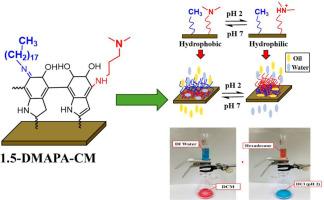纤维素基ph响应智能膜选择性去除油和水
IF 6.3
3区 工程技术
Q1 ENGINEERING, CHEMICAL
Journal of the Taiwan Institute of Chemical Engineers
Pub Date : 2025-09-17
DOI:10.1016/j.jtice.2025.106411
引用次数: 0
摘要
背景工业废水中油类和有机物的去除对环境污染治理具有重要意义。然而,从水中高效、简单和经济地分离这些污染物仍然具有挑战性。方法制备具有良好可逆润湿性的纤维素基ph响应智能膜。在纤维素膜上涂覆聚多巴胺(PDA),以引入活性位点进行进一步修饰。选择二甲氨基丙胺(DMAPA)和十八乙胺(ODA)分别作为ph响应材料和疏水材料。改性纤维素膜的表面润湿性在中性条件下的疏水性和酸性环境(pH 2)下的亲水性之间切换。因此,这种纤维素膜具有很大的适用性,可以根据水的pH值选择性地去除油或水。在两种情况下,膜的分离效率均达到99%。该膜还能吸附水中的油脂,并在酸(pH 2)中进行解吸,表现出“自清洁”能力。这种智能膜在油水分离方面具有很大的应用潜力。本文章由计算机程序翻译,如有差异,请以英文原文为准。

Cellulose based pH-responsive smart membrane for selective removal of oil and water
Background
Removal of oil and organic compounds from industrial wastewater is of great importance to environmental pollution control. However, efficient, simple and cost-effective separation of such pollutants from water is still challenging.
Methods
A cellulose-based pH-responsive smart membrane with excellent reversible wettability was developed. Cellulose membrane was coated with polydopamine (PDA) to introduce the reactive sites for further modification. Dimethylaminopropylamine (DMAPA) and octadecylamine (ODA) were selected as pH-responsive and hydrophobic materials, respectively.
Significant findings
The modified cellulose membrane switches surface wettability between hydrophobic under neutral condition and hydrophilic in acidic environment (pH 2). Therefore, this cellulose membrane has great applicability to selectively remove oil or water according to the pH of water. The membrane exhibited high separation efficiency of 99 % in both cases. The membrane also absorbed the oil in water and desorbed it while immersing in acid (pH 2) presenting the “self-cleaning” ability. Such a smart membrane has significant potential in oil-water separation.
求助全文
通过发布文献求助,成功后即可免费获取论文全文。
去求助
来源期刊
CiteScore
9.10
自引率
14.00%
发文量
362
审稿时长
35 days
期刊介绍:
Journal of the Taiwan Institute of Chemical Engineers (formerly known as Journal of the Chinese Institute of Chemical Engineers) publishes original works, from fundamental principles to practical applications, in the broad field of chemical engineering with special focus on three aspects: Chemical and Biomolecular Science and Technology, Energy and Environmental Science and Technology, and Materials Science and Technology. Authors should choose for their manuscript an appropriate aspect section and a few related classifications when submitting to the journal online.

 求助内容:
求助内容: 应助结果提醒方式:
应助结果提醒方式:


